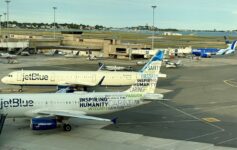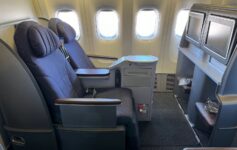For all the complaints about US Airways being a “low-cost carrier” or offering an inferior in-flight product, the carrier has been a valuable member of Star Alliance that will be missed tremendously. With a healthy European route network and an expansive route map in the Southeast and Northeast, US Airways has nicely complimented United’s route network and been very generous with award space, particularly with North American premium cabin space. US Air’s departure from Star Alliance leaves a gap that no other airline can fill, but courting a second domestic airline still makes sense—and that leaves only Alaska Airlines.
Let’s tackle the immediate objections. For what possible reason would Star Alliance want to pursue Alaska Airlines when Alaska and United have a route network with tremendous overlap?
It is true that bread and butter routes like Los Angeles/San Francisco/Newark/Houston to Seattle are currently served by both carriers, 26 city paires in all. Alaska and United even compete on the Seattle to Anchorage and Portland, Oregon to Seattle routes. While Alaska offers extensive service in the Pacific Northwest with hubs in Portland and Seattle, so does United from San Francisco and Los Angeles.
But Alaska offers an impressive number of Hawaiian flights from secondary west coast cities that would give Star Alliance an added boost to its route network, inviting the expansion of Star Alliance service to Seattle. Alaska also flies to key destinations across the USA, giving Star Alliance passengers more options including non-stop service between Los Angeles and Washington Reagan. With service to Dallas, Houston, Atlanta, Chicago, Philadelphia, Boston, Newark, and Orlando, the carrier could help to fill in the void left by the elimination of Star Alliance hubs in Phoenix, Charlotte, and Philadelphia. And let’s not forget the carrier’s name—Alaska would be much more easily reachable. Let’s also not forget that US Airways also competed head-on with United on a number of key routes to the benefit of both carriers and to consumers.
Let’s face it, though—convincing United will be a tall task and United is probably celebrating US Airways’ departure from Star Alliance, which will funnel more Star Alliance traffic to United. But an extensive codeshare agreement would not be necessary for Alaska to benefit Star Alliance…and United. The question is would United exert its veto power to block Alaska from joining?
If United believes that Star Alliance passengers from Asia and Europe would opt to connect in Seattle or Portland instead of one of its hubs, thereby totally bypassing United, then support for Alaska is unlikely. But there is another way to look at this.
Alaska has a decent route network, but it pails in comparison to United’s, which is strong in the West, Midwest, Northeast, and South, even conceding US Airways has a better Southeast and Northeast network. Imagine Alaska flights feeding into United’s flights to smaller cities rather than to flights on Delta or American. Imagine Alaska selling United flights rather than Delta or American flights to connect to its own flights.
Yes, Alaska may take some business away from United on routes between big cities, but it has the potential to give United a golden opportunity to pick up more traffic to its secondary cities that otherwise would go to Delta or American. Furthermore, since Alaska’s international destinations are limited to Mexico and Canada, Untied stands to benefit from Alaska feeding into United’s more lucrative international flights going to points around the world.
That gets to the second problem—Alaska already partners with a number of carriers, including Delta and American, and none of its international partners (LAN, Cathay Pacific, Fiji Airways, Emirates, British Airways, Qantas, among others) are Star Alliance members. With a handful of oneworld partners, it seems more logical that Alaska would join oneworld, but with American and US Airways now merging, the need for a second North American carrier in oneworld is less pressing (though the relative weakness of both AA and US in the Pacific Northwest still make Alaska very attractive to oneworld).
What about Delta? Delta has chosen to wage open war on Alaska, making Seattle a hub and competing head-on with Alaska on a number of routes. Alaska has responded by making Salt Lake City (a Delta hub) a focus city. I think the relationship between Alaska and Delta is on thin ice and will be over by the end of 2014.
That means there are three choices—status quo, Alaska joins Star Alliance, or Alaska joins oneworld.
It is a forgone conclusion that any alliance that gains Alaska Airlines would be strengthened. The question is does Alaska want to enter an alliance and does American or United want Alaska? The way I see it, Alaska’s route network will always be limited so it will be forced to continue to rely on airline partners to transport clients to small cities outside of the Northwest who wish to fly on Alaska as much as possible. That is a golden opportunity for the U.S. airline who can make the better pitch through its larger alliance.
Alaska is the last holdout in the alliance game and I hope that Star Alliance will aggressively court Alaska Airlines with the blessing of United. Star Alliance, its airlines, and consumers would all benefit.
But let’s be realisitic–my assessment that Star Alliance should puruse Alaska is nothing more than that. I am not arguing that Alaska must join Star Alliance (or any alliance) or that Alaska has any desire to break up the rather sweet deal that it has now with so many carriers by playing the field. I am not even arguing that joining Star Alliance is the best course for Alaska. I am simplying arguing that Star and Alaska should sit down and talk.
A final word on JetBlue. Many have floated the prospect of JetBlue joining Star Alliance. JetBlue has a strong route network in the Northeast, Southeast, and Caribbean and is partially owned by Lufthansa. It is also adding premium cabin space for the first time and though called a “low cost carrier” is arguably more full service than many of the legacies.
JetBlue would be a nice addition to Star Alliance as well, but I think United would more strenuously object to a carrier competing for New York City traffic than it would to Alaska. I also note that United covers from Newark most of what JetBlue covers from JFK or Boston, and JetBlue does not have the reach to Alaska and Hawaii that Alaska Airlines does.
So I would rather see Alaska than JetBlue and also think Alaska is a more realistic option, though either carrier may be a pipe dream.
For a different take on this issue, see Rocky’s Alaska Airlines: Star Alliance – I think Not; OneWorld – Maybe




I’d rather have Alaska independent as they are right now. The partnership thing works better for us since we can earn/burn on a variety of airlines.
No way! The industry has consolidated enough. Hands off AS!
I don’t think the promiscuous prom princess is ready to settle down just yet.
As will never join star alliance. There is way to much bad blood and history between ua and as
Perhaps you’re right, and Alaska will join Star to beat back Delta’s encroachment.
However, another way to look at this might be to consider the possibility that Delta is investing heavily in the Northwest to make Alaska more amenable to a merger or alliance deal. By forcing Alaska into a corner, Delta strengthens its position and forces Alaska to make a decision to join with Delta in some way to halt the advances.
Interesting take on JBU. There are so many oddities about the New York market that if it’s spun right, I think that one could manage JBU in Star.
You’ve got EWR as a captive hub for United, hopelessly outdated JFK serving huge O/D traffic for every flag carrier and impossible to dominate, and LGA messing up the airspace in between. After NextGen goes in there will be some more airspace capacity but not much. Without a major mode shift to high-speed rail for short haul flights, it’s a mess.
Taking that as read, and accepting that JFK is a strange throwback to the pre-hub era, say you want to start locking the O/D crowd into Star. UA is about 75% at EWR and JBU is 24% of JFK. UA and JBU serve some fairly different markets at those hubs, but Star would become the most diverse alliance in the NY market. Capture the Boston weekenders with JBU, then ship them halfway across the world with UA.
Stranger things have happened, so I think that it really depends on what UA wants out of the New York market.
You touched on it, but overall this post was more about why *A should pursue AS. I think the bigger question is why would AS want to join *A, or any alliance, for that matter? If I’m AS, I’m sitting back thinking I’ve already built an alliance of sorts through individual partnerships, and if I’ve had a drink, I might even say it’s the 3rd best in the US (ahead of Skyteam).
Personally, I like what AS is already doing. Their next move might be to strike a partnership with a *A carrier, as they already have the advantage over the other domestic airlines by partnering with OW and ST members. Heck, I’m considering AS elite status and I live in the NorthEAST, just based on the benefits and flexibility it’d give me in flying AA or DL.
There is WAY to much I could say on this issue and am in disagreement in a lot of areas. There’s to much overlap and *A is a bad fit for AS. I will be writing a rebuttal post instead 🙂
Rebuttal now live: http://upgrd.com/blogs/doublewidesfly/alaska-airlines-star-alliance-i-think-not-oneworld-maybe.html
This seems pretty silly to me… You basically refute most of your points right in the article!
Interesting and thought provoking read…